When I booked this lesson I knew it would be with an instructor I’d never flown with before. No matter how many times you do it, this always fills you with reservations: Will I just magically forget how to fly and look ridiculous? Will they have different opinions on procedures/landing technique etc. Even with a license in your bag, these thoughts don’t seem to go away – in some ways perhaps a license can make them worse, as with driving I’m sure if you spend enough time away from “the proper techniques” you develop bad/personal habits.
First Impressions
It’s human to develop opinions about people on first impressions, you shouldn’t but you do.
On meeting, the opening volley of conversation didn’t leave me overly thrilled about going flying. A sense of almost “I’ll tell you what we’ll be doing – you clearly have no idea” in the air. Still, we might always have first impressions but I’ve had them about all the instructors I’ve gone flying with and they’re often wrong. So let’s skip past this front cover and see if the first pages make the book worth reading 🙂
Briefing
Objective was to finish off my emergencies, left on the cards:
- One straight forward normal night circuit
- Radio Failure
- Internal Lighting Failure
- Total Electrical Failure
If all that went well the instructor said he might jump out and let me go solo. This book is getting better already!
Taxi and Take-Off
A few ‘instructor in the plane’ jitters, managed to skip over turning the Nav lights on, started taxing with the flaps down 🙁 See this stuff was never drilled into me in training: Re-set Power to 1,200 RPM after everything, absolutely and utterly drilled into me!!
Throttle Open, the Cessna charges down the runway into the dark sky.
I know a mile of runway is ridiculously more then a Cessna 172SP needs, you could take off and land on it about 3 times before running out. Honestly though, it never gets old to line-up on the centre line, a mile of asphalt ahead of you and to then open up the throttle, in control of an aeroplane!
Let there be Music!?!?
My log book says I’ve done literally hundreds of take-offs, sure this is about take-off number 15 in the dark, but short of an engine failure the show is pretty much routine for me now. Well it was until about 300ft off the ground a voice over the intercom says “Hey how about some music?”
Errrrrrrm, dunno, yes I guess – my brain just couldn’t quite grasp the question.
A second later, there was music coming through my headset! Sure it wasn’t the latest chart topper but it was a complete first. Not only was I a bit stunned that hey I’m supposed to be training for a night rating here, shouldn’t I be trying to soak up every second of wisdom and good instruction?? Second, we’re 300ft off the ground, not cruising along with with a basic service on a constant heading for 20 nautical miles. That being all said, it made me laugh and began to shatter my first impressions.
The music stayed on for most of the downwind leg, I got a little brief about the ADF and its other uses (i.e. it’s essentially a Long Wave radio receiver) 😛
As I turned base the music went off and I could focus on landing the plane, which actually came together really quite nicely and I touched down just a few feet past the numbers all very much like it was intended to happen.
Flaps up, power back on and away we go.
Radio Failure
The instructor told the tower we wanted to simulate a radio failure, which they accepted. Now the name of the game is to look for a green constant light coming from the tower, indicating it’s ok to land at this aerodrome.
My first thought was “How big/bright is this green light supposed to be?” I’ve been on a ‘Tower Tour’ at Cambridge which if you get a chance is worth doing and been up close to one of these green spot lamps – but even so that doesn’t really give you a clue as to what it looks like in the dead of night with a major city in the background.

Proper Signalling System
You want to imagine a Green light signal, like the Bat Signal projecting into the sky to give a very reassuring “Yes, this signal is for you…..come and land here”. Sadly it’s nothing of the sort, a green dot might be doing it an injustice but it’s not the biggest light in the world to try and pick out and with half of Cambridge in the background, plus a Green aerodrome beacon light flashing away – it’s hard to tell one green light from another. You can’t put a price on safety, but if you could, it’s less then the cost of a massive spot lamp with “LAND HERE” taped across the beam apparently 🙂
Still the goal of this circuit was all about what I’ve said above, familirisation – what would the light signals look like? It’d be a nightmare to try and spot them if you’d never seen what you were looking for and had just read the text books. I’d obviously be looking for a bat sign and that would have got me nowhere 😉
Interestingly the tower still gives a radio call, but prefixes that the call is blind to our aircraft. Which again was interesting learning of what to expect on returning to an aerodrome with a failed radio.
One thing to note about night flying, the only airfields you can typically do it from are places like Cambridge, Norwich etc. big aerodromes that are licensed and have all the kit etc. but equally these are the same places where the circuit traffic tends to be quite high and returning to one without a radio and thus without agreed join instructions etc. is something done under considerable caution and care.
My landings were on form tonight and it was another pretty much as good as I can do landing. So good it was now drawing complements from my instructor which is always nice – because god knows in my training days I’ve slammed my fair share of Cessnas into the tarmac hard! (Crosswinds used to be my Nemesis).
Internal Lighting Failure
It’s a requirement of a night approved aircraft to have internal lighting for the use of being able to read airspeeds etc. which is great, except when you follow the schematics through you’ll find that it all comes off 1 battery through a single circuit breaker. So if one light shorts, you’ll probably lose the lot!
The cockpit of a Cessna, even with night vision developed is a dark place and you can pretty much forget being able to read the airspeed. That’s why you remembered to bring a torch and tested the batteries in your pre-flight checks right? 🙂
With torch found, my fear of its default bright mode was realised, but another quick click and it dropped to a low power red beam which actually lit the cockpit in a very nice haze of red. God knows what it looked like from the ground! 😉
However, having all the instruments lit in a glow of red light with the torch essentially just dumped on the seat did work particularly well. No faffing about trying to fly the plane with one hand and control throttle, trim and torch with the other.
It resulted in essentially no noticeable difference in my flying whatsoever and the final approach was flown as good as any with internal lighting so I found myself really settling into this lesson. It couldn’t have been going much better.
Total Electrical Failure
Finally a simulated total electrical failure, so no internal lights, no radio and no flaps (and a note from the instructor that the avionics would be gone so we wouldn’t even be talking to each other over the headsets at least). I suppose a sensible course of action would be to land the plane then! 🙂
If you read back through this blog to my training in the circuit, my flapless landings were my best. I could land with the flaps up all day long, it was with them down that it took what felt like an age to become slick.
The torch continued to perform brilliantly, really liked the red illumination of all the instruments, really made flying the plane easy.
Lack of a landing light really messes with the depth perception of the runway so the touch down was a bit harder then I’d have liked but the instructor seemed very happy with it all.
Fancy doing one on your own then?
First Night Solo: Circuit
We pulled off the runway and the instructor jumped out with the usual final words of wisdom and checks that I’m really happy in myself and he’s not just pushing me into a flight I don’t want to do etc. (It might sound daft, but accidents have happened because students have gone solo when not comfortable in their own minds about doing it).
I always forget to get the airfield information again after the instructor jumps out, a ‘large airport’ problem that Cambridge has an ATIS. Thankfully Air Traffic Control weren’t to grumpy at me and just gave me the QFE and away we go, thanks to them as always 🙂
Throttle open and away into the dark night sky – all on my own!
Your first solo is a special moment, I can remember when I did mine getting to 200ft up and thinking “well I have to land it on my own now…”. Many hours have gone by since and I’m a better pilot now (I have paperwork to prove it! 🙂 ), so I found this take off and turn on to the Crosswind leg actually really quite a peaceful experience, a sort of nice walk in the park flight. Very different to the “have I checked everything” / actively thinking hard first day light solo. Muscle memory taking over for much of the effort of flying the plane.
Another good touch down, my landings really were on form today.
Vacate and Taxi to Hanger
As the temperature was dropping, the Cessna’s were clearly getting put away for the night in the warm of Hanger 2. Air Traffic Control gave me a Taxi clearance to the hanger, which I could just about remember how to follow – 99% of the time you taxi to/from the grass parking, but Cambridge Airport has a lot of other places you can go and a lot of other holding points and taxi ways available.
If in doubt : SHOUT!
You won’t get any points for guessing when taxing around an airport, you’ll get even less points if you go somewhere you’re not cleared to go! At best you’ll start to annoy ATC, at worst you’ll either begin to endanger other users or end up hitting something. Sure the Cessna 172 was designed many years ago, but they’re still far from cheap toys to go pranging into a fuel bowser or even worse another expensive toy you should never have been near if you’d gone the right way.
Although I knew in my mind where I was going, I felt there was no harm to just double check with ATC I was about to turn left at the correct point, after all the airport was quiet – if I’d hit something the fact ATC weren’t busy etc. and could have given me clear advice would have been another black mark in the accident report of signs of poor airmanship. The worst I’ll have got for asking is some remark in the tower about how ‘students’ don’t know the airport – eh I can live with that, but I think the ATC guys/gals at Cambridge are above that standard and were probably happy to help and have something to do.
Once parked up outside the hanger and the engine off, just the matter of helping out pushing the planes into the warmth. Always good fun, if you don’t like pushing aircraft around when the meter isn’t running, learning to fly isn’t for you 😉
Debrief and What’s left?
My instructor was full of praise for my flying, always nice, particularly full of praise on my landings. I’m sure they just say that to make you come back and fly some more 😛
That said the lack of any negative points or things to brush up on was very satisfying.
With all my emergencies and duel hours required clocked up, all I have left to do is complete my 5 solo full stop landings – so next lesson should be a simple check ride with an instructor, they’ll hop out and I can crack on and complete 4 solo full stops. Job done.

